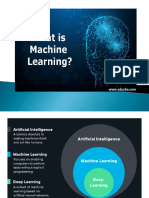Introduction to Machine Learning
Uploaded by
Suleman KtkIntroduction to Machine Learning
Uploaded by
Suleman KtkWhat is Machine Learning?
• Machine Learning (ML) is a subfield of artificial intelligence (AI)
• gives computers the ability to learn and make decisions
• without being explicitly programmed for every specific task.
• Instead of relying on hard-coded rules,
• machine learning systems are trained on data and learn patterns,
relationships, and trends, use to make predictions or decisions.
• The key idea behind machine learning is that systems can
automatically improve
• through experience, without human intervention.
Why Machine Learning?
In today’s data-driven world, machine learning is crucial for solving complex
problems that are difficult or impossible to address with traditional
programming. Some of the key reasons to use machine learning include:
Handling Large Datasets: ML algorithms can analyze vast amounts of data
much faster than humans.
Pattern Recognition: ML can uncover hidden patterns and trends in data.
Automation: ML models can automate decision-making processes and
improve productivity.
• Adaptability: Machine learning models can adapt to new data over time,
improving their accuracy and effectiveness.
Types of Machine Learning:
1. Supervised Learning:
o In supervised learning, the algorithm learns from labeled data. This means each
example in the training set is paired with the correct output (label). The goal is to learn a
mapping from inputs to outputs that can be used to predict unseen data.
o Examples:
Classification: Predicting discrete labels (e.g., spam detection, image classification).
Regression: Predicting continuous values (e.g., house price prediction).
o Example: Training an email filtering system to classify emails as "spam" or "not spam"
based on a dataset of labeled emails.
2. Unsupervised Learning:
o In unsupervised learning, the algorithm works with unlabeled data. The goal is to find
hidden structures or patterns in the data.
o Examples:
Clustering: Grouping similar items together (e.g., customer segmentation).
Association: Discovering relationships between variables (e.g., market basket
analysis).
o Example: Grouping customers with similar purchasing behavior without predefined
Types of Machine Learning:
3. Reinforcement Learning:
o Reinforcement learning involves an agent interacting with an environment
and learning by receiving feedback in the form of rewards or penalties.
The agent makes decisions to maximize long-term rewards.
o Example: Training a robot to navigate a maze by rewarding it when it
moves closer to the goal and penalizing it when it makes a wrong move.
4. Semi-Supervised Learning:
o Combines both labeled and unlabeled data. Often, labeled data is scarce
and expensive, so algorithms are designed to make use of large amounts
of unlabeled data with only a few labeled examples.
o Example: Image recognition tasks where only a small portion of the
dataset is labeled.
How Machine Learning Works:
1. Data Collection:
1. Gather and prepare the data. This includes obtaining labeled data for
supervised learning tasks and ensuring it is clean, accurate, and
representative.
2. Feature Selection and Preprocessing:
1. Feature selection involves identifying the most relevant data points
(features) that will help the model learn.
2. Preprocessing involves cleaning and transforming the data into a
format that the algorithm can use (e.g., handling missing values,
normalizing numerical features).
3. Model Selection:
1. Choose a machine learning algorithm based on the type of problem
(classification, regression, clustering, etc.). Common algorithms include
How Machine Learning Works:
4. Training:
o The model is trained on the training dataset. During training, the model
learns the relationships between input features and the desired output by
minimizing the error in predictions (loss function).
5. Evaluation:
o After training, the model is tested on unseen data (test set) to evaluate its
performance. Common evaluation metrics include accuracy, precision,
recall, and F1 score.
6. Prediction:
o Once trained and evaluated, the model can be used to make predictions
on new, unseen data.
7. Model Improvement:
• Based on evaluation results, the model can be fine-tuned, retrained on more
data, or adjusted to improve performance.
Challenges in Machine Learning:
1. Data Quality:
1. High-quality data is crucial for the success of machine learning models. Poor data
quality (e.g., missing or noisy data) can significantly affect the model's
performance.
2. Overfitting and Underfitting:
1. Overfitting occurs when a model learns too much from the training data and
fails to generalize to new data.
2. Underfitting happens when a model is too simple and fails to capture the
complexity of the data.
3. Model Interpretability:
1. Complex models (e.g., deep neural networks) can be difficult to interpret, which
is a challenge for applications where understanding how the model makes
decisions is important (e.g., healthcare, finance).
4. Bias and Fairness:
o Machine learning models can inherit biases from the training data, which can lead
to unfair outcomes, especially in sensitive applications like hiring or loan
You might also like
- Machine Learning Is A Branch of Artificial Intelligence (AI)No ratings yetMachine Learning Is A Branch of Artificial Intelligence (AI)80 pages
- Machine Learning Intro for Absolute BeginnersNo ratings yetMachine Learning Intro for Absolute Beginners3 pages
- Machine Learning: BY: Jeshwanth Singh, Soumya Ranjan Sahoo 5 Sem CsNo ratings yetMachine Learning: BY: Jeshwanth Singh, Soumya Ranjan Sahoo 5 Sem Cs20 pages
- Introduction to Machine Learning BasicsNo ratings yetIntroduction to Machine Learning Basics12 pages
- Class Notes: The Basics of Machine LearningNo ratings yetClass Notes: The Basics of Machine Learning4 pages
- Machine Learning with Python: Foundations and Applications: ML, #1From EverandMachine Learning with Python: Foundations and Applications: ML, #1No ratings yet
- Moons M Servo Suite User Manual 2015 en v1.1No ratings yetMoons M Servo Suite User Manual 2015 en v1.1111 pages
- CIS Oracle MySQL Community Server 5.7 Benchmark v1.0.0No ratings yetCIS Oracle MySQL Community Server 5.7 Benchmark v1.0.077 pages
- Part VI - NVIDIA Mellanox Bluefield-2 SmartNIC Hands-On Tutorial Levente Csikor CodeXNo ratings yetPart VI - NVIDIA Mellanox Bluefield-2 SmartNIC Hands-On Tutorial Levente Csikor CodeX45 pages
- Alibaba Cloud Server Load Balancer: Product IntroductionNo ratings yetAlibaba Cloud Server Load Balancer: Product Introduction29 pages
- Virtual User Interface For Industrial Robots Off-Line Programming & Simulation and Video Cam On-Line Remote OperationNo ratings yetVirtual User Interface For Industrial Robots Off-Line Programming & Simulation and Video Cam On-Line Remote Operation6 pages
- (Skiena, 2017) - Book - The Data Science Design Manual - 3No ratings yet(Skiena, 2017) - Book - The Data Science Design Manual - 31 page
- Training Document For Comprehensive Automation Solutions Totally Integrated Automation (T I A)No ratings yetTraining Document For Comprehensive Automation Solutions Totally Integrated Automation (T I A)45 pages
- Claret College of Isabela Isabela City, Basilan First Semester School Year 2016-2017 Syllabus in Fundamentals of Information SystemNo ratings yetClaret College of Isabela Isabela City, Basilan First Semester School Year 2016-2017 Syllabus in Fundamentals of Information System11 pages
- Panelview 800 Hmi Terminals: User ManualNo ratings yetPanelview 800 Hmi Terminals: User Manual168 pages
- Theory of Computation - Need Solution ManualNo ratings yetTheory of Computation - Need Solution Manual3 pages
- Clinger - Implementation Strategies For First-Class ContinuationsNo ratings yetClinger - Implementation Strategies For First-Class Continuations39 pages

























































































